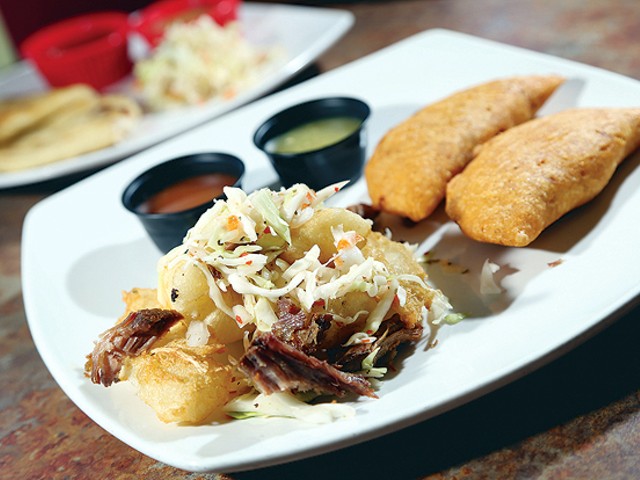WE DON'T NEED NO FIRE — Do sensible fire safety rules consign residents to a diet of processed, nukable food? Not necessarily. Just because you only have a microwave doesn't mean you have to live on boxes of fatty, salty meat dumplings. Microwaves can make some great mashed potatoes, and can crisp up fuss-free potato skins, if you're willing to put the effort in. And a host of cold recipes — such as gazpacho, salads, guac or even trail mix — can be whipped up without heat at all, making quick, healthful snacks.
TOOL TIME — To outfit your kitchen, all you really need is a peeler, a can opener, a wooden spoon, a grater, a cutting surface, a few sharp knives, some sort of strainer and some tongs. You won't need inside-the-shell egg scramblers, lettuce spinners or even a garlic press if you're willing to hone your chops. Use your knives.
GET IT FRESH — If, somehow, you can use an actual kitchen to prepare food, things get fresher and cheaper. Instead of getting overprocessed fare like fish sticks and French bread pizzas, you can get right to the source, using fresh produce. Some of our biggest schools are located in areas with farmers' markets where you can buy food at the peak of freshness. Ypsilanti and Ann Arbor have three between them, and Detroit has not just Eastern Market but the Wayne State's weekly green market. Not only is that sort of food better for you, it requires the least preparation. Even a half-ripe tomato sliced and lightly salted can be a delicacy.
SMART SHOPPING — Forget every brand name or ad campaign you ever heard of. Instead of shuffling through the supermarket, shopping at eye level, look down near the floor for the cheaper knock-offs. Spartan brand products aren't just cheaper packages of the same products you'd pay more for with a brand name, they're also a Michigan-based company.
GO ETHNIC — If you can't find a farmers market or a food co-op, it can be difficult to get affordable quality produce. Organic retailers are a little high-end for the chump-change set. Luckily, ethnic markets offer excellent produce at reasonable prices. Their customers demand quality — you get to share in it.
FLESH FOR SALE — Though a vegetarian diet may promote better health, the good news for meat eaters is that meat is still subsidized and cheap protein for the taking. Novice meat-shoppers beware: The best cuts aren't solid-red; they're marbled with fat in intricate veins, but don't be fooled by chuck. Steak-lovers can rejoice that, in America, we can enjoy the finest steaks that $5 can buy, brushed with salt and pepper and grilled four to six minutes on a side. Comb classifieds and Craigslist for a cheap hibachi.
CHEAP STUFF — It's not a mistake that such Amerindian staples as potatoes, corn and squash are cheap wonders in the kitchen. Until medieval times, these vegetables were unknown in the Old World. When early explorers brought them from the New World, the shit-ton of nutrition in them helped kick off a population explosion in Europe.
SAVED BY SPUDS — Potatoes in particular are a wonderfully versatile vegetable. Sometimes selling for as little as 10 cents a pound, all you need to do is stab the hell out of one, chuck it in the microwave for 10 minutes, slash it open, shower it with chopped chives and sour cream, and you get hundreds of calories, potassium, vitamins C and B6, little cholesterol and no sugar. Slice them in half, rub them with salt and rosemary and bake them for an hour to get a nice roasted flavor. If you want to exploit the tuber's starchy goodness, take a gander at the potato volume in the Williams-Sonoma Collection for an idea of its versatility.
ROOTS ROCK — For snacks, soups and stir-fries, the carrot is essential. For a fuss-free snack, peel carrots and keep them submerged in a glass of water in the refrigerator. Don't be fooled by "baby-cut" carrots — they're mature carrots cut to resemble the real delicacy. Look for mature carrots that snap when bent. Don't pass up on its pale cousin, the parsnip.
USE YOUR HEAD — Yes, the smell of cabbage is associated with the tenement house. Sure, broccoli can turn your bowels into bellows. But for those with solitary ways (or with forgiving scholars sharing your dorm room), the cabbage family can't be beat for nutrition. Steamed, stir-fried or stewed, they pack a lot of punch.
SIMMER DOWN — Don't boil vegetables. The American table is plagued by the last vestiges of bad English cooking: boiling things until dead. They have already overthrown the practice in Britain, where curry has become the reigning national dish. Why boil away good nutrition? For flavor and texture, steaming or cooking al dente yield the best results. And if you must have baby-food softness in your vegetables, try soups and stews.
DON'T GET THE JUICE — Unless you're fighting a UTI and need cranberry juice or enjoy lugging a few quarts of liquid for exercise, fruit, for fiber and flavor, is preferable. If you must drink juice, get the cheaper frozen concentrate and mix it at home. If you must have liquid juice, get the real thing and not sugared-up "juice drink."
TAP THAT — Water: It's almost free. Why drink anything else? Garnish with ice and serve.
WHAT'S POPPIN' — If you've been subsisting on those microwavable pouches, you've been missing out. It's much cheaper to pop up by the pound, and digging into a buttered and (lightly, please!) salted tub of popcorn goes down real good with the Netflixes. Once you've indulged, you'll happily sacrifice one of your pots to the Native American snack, or, better yet, invest in a popper with a spinning rack to keep those kernels from burning. You'll never go back to cheesy-poofs.
ASIA'S CEREAL — There's more than a grain of truth to the phrase "billions can't be wrong." If about half the world's population practically lives on the stuff, it follows that our college students can too. Even the priciest rices — sticky Japanese rice, supple basmati rice — are affordable in large quantities. But you'll have to get it in bulk, and the best can be had at ethnic markets. You might just break up with old Uncle Ben and hook up with a rice cooker.
BEAN BAGS — Dehydrated beans are a great value. Just soak them in a bowl in the fridge and they're good to go, some of the cheapest protein around. So why don't more people do it? Because it sucks. You have to plan a day ahead, soaking them for hours and hours. But somebody recently pointed out to us that the soaked beans can then be frozen in smaller servings, ensuring an easy supply of tender, soaked beans. We cannot argue with this strategy — at least for anybody single, or dating an eproctophiliac.
ONE BIG POT — Let's face it, you're busy! Between your gigs and your classes, you're too worn out to cook every day. Well, focus on a strategy of cooking one large dish, usually in an oversized pot, and keeping it covered all week in the fridge. All-week chilis, lentil dishes, soups and stews can be reheated and cooked down bit by bit, with the various juices swapping for better flavor. And, if it starts to get dull around finals week, splash on the hot sauce for better leftovers.
GROW YOUR OWN — Even if you don't have a lot of space, you can still grow some herbs in a southern window. Basil, parsley or cilantro can help spice up your hashes, and help you dodge the industrially dried and irradiated spices you'll find in the supermarket. Add water and harvest.
STINKROOT — Only sissies complain about onion — or garlic-breath. These sturdy bulbs are the greatest, most versatile vegetables for the frugal cook. Go for the small, tight bulbs; the large ones are only full of water. Simmering and sautéing heightens the flavor, and only small amounts of sautéed garlic or caramelized onions can alter a dish for the better.
FOOD FLUFFING — Sometimes, the same old cheap eats get boring. That's where "food fluffers" come in. They add spice to commonplace meals and help make leftovers appetizing. If you want to cook up a Ravi Shankar special but are confounded by Indian powders and spices (and have a bit of extra money to spend), S&B brand Golden Curry products come in dissolvable cubes. Don't stop at sriracha; Sambal, a ground chili paste, will make even the saddest leftovers palatable. Huy Fong Foods makes an incendiary sambal oelek, available at better supermarkets. The most effective fluffers can be found free at restaurants: mustard and ketchup. Don't sneer: Mustard can bring days-old chili back from the brink.
NOW YOU'RE COOKING — Experiment with new recipes. Cookbooks are usually the cheapest items in a used bookstore. Challenge yourself. Building your food preparation skills is easier and more rewarding than you might think. Kick your skills up enough, and you'll earn bragging rights among your friends.
BOHEMIAN RECIPES
$2.50 Pasta Sauce
Can of tomato paste
1 cup chopped onions
1 finely chopped toe of garlic
2 tablespoons olive oil
1 pinch salt
1 tablespoon oregano
1 tablespoon basil
1 can peeled tomatoes
Heat olive oil in a saucepan. Sear garlic by stirring it quickly, then toss in the onions and stir. Just as they are starting to soften and turn brown, add the tomato paste. Watch for it to soften and brown a bit, then add the tomatoes and salt and spices. Bring to a boil and then simmer.
Tastier tuna sandwich
1 can tuna
3 tablespoons salad dressing
2 celery stalks, finely chopped
4 slices of bread
1 teaspoon cumin (optional)
1 teaspoon mustard (optional)
Whisk together tuna, salad dressing, celery. Spread on toasted bread and add a dash of cumin or splork on the mustard. Makes two loaded sandwiches.





